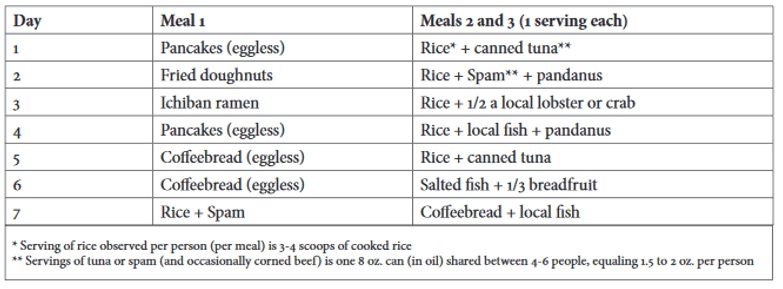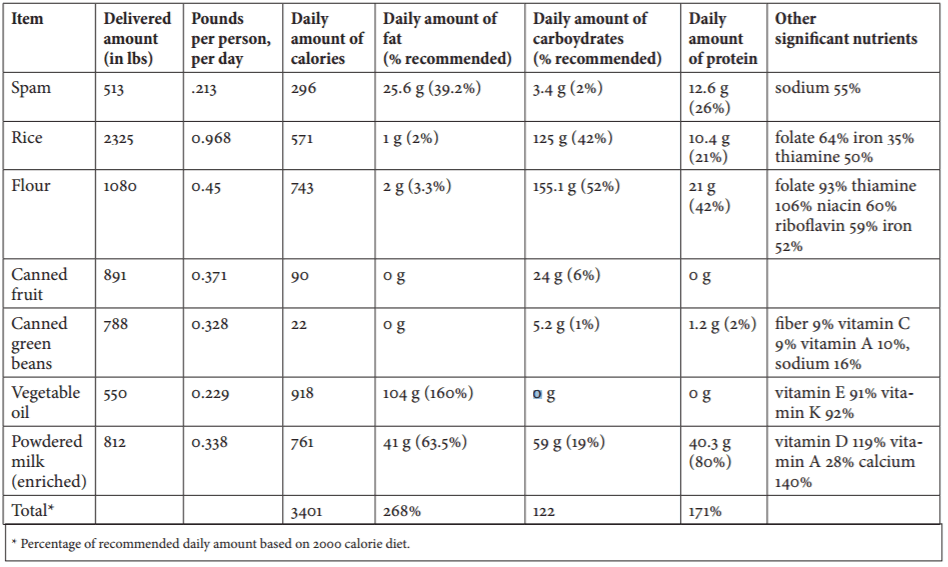Carley Trentman
Kansas, United States
When one mentions World War II, vivid images come to mind. The controversial decision to use the atomic bomb in Hiroshima and Nagasaki marked the end of the war in 1945. Subsequent testing of hydrogen bombs occurred in the 1950s on the Marshall Islands, where “Ivy Mike” and “Castle Bravo” were detonated. Ivy Mike was the first thermonuclear device ever detonated. Castle Bravo was the largest yield device detonated by the U.S. and deposited significant radioactive fallout on the Marshallese people. The lifestyles, health, and environment of the Marshallese before and after the detonation of Castle Bravo and Ivy Mike contrast drastically. One revealing difference is a nutritional comparison of this population before and after World War II. Examining health from an infant weight or BMI position prior to World War II is difficult because data are scarce. The Marshall Islands were under Japanese Imperial control from 1919 to 1945 and this data is not readily accessible.
Nutritional lifestyle data was much more accessible, and the pre-war information had not been explored deeply in many other research articles pertaining to Marshallese health.
From 1920-1954 the population of the Marshall Islands did not exceed 12,000 amongst all of the atolls combined.1
Anthropologist Dr. Nancy Pollock’s extensive examinations and calculations of this area were helpful to the examination of nutrition prior to World War II. “One difficulty is that pre-1945 diets have not been subject to close scrutiny, so there are few firm data to use as baseline […] the best we can do is make a guestimate.”2 This estimate was done by taking approximate averages of meals consumed on a daily basis. The total caloric intake, including feasts, snacks, and daily meals, totaled 2,000-3,000 per day over a one-year cycle. However, on any given day intake could be as little as 0-1600 calories and on feast days over 4000.2
Calorie amounts aside, the actual consistency of the pre-war diet was primarily roots and fruits, with the accompaniment of fish as a side dish rather than a meal’s entree. This diet was high in carbohydrates and fiber but lower in sucrose and protein.“The beaches of the Marshalls where coconut trees have long been planted for copra production, as well as other utilitarian purposes, are often littered with nuts . . .”3 This is a good indication of how nuts and fruit comprised 80% of their caloric intake.3 An additional way to examine nutrition is to delve into total food consumption by household. In tabular form, seven different families are shown with Household IV being nobility and the other six commoner households.4 These data were collected over a three-week span.

Another aspect that plays into nutrition in the Marshall Islands is the social construct of food. While in the Western world food may be viewed as a substance needed to maintain biological existence, the Pacific view is much more symbolic. Food and eating bind social groups together.2 This differing view may contribute to the changes in Marshallese health before and after World War II, as the frequency and amount of food may be altered if its consumption is deemed socially necessary rather than simply fuel for life. Nancy Pollock describes this, “In contrast, by local Pacific standards, so-called obese people have been highly regarded both in the past and at the present time. They were a walking reminder that their society was a caring one, within which such persons were well provided for. They were positive social symbols to the wider world of their society’s well-being.”2 This touches on the cultural difference of what it means to be heavier in the Marshall Islands at this time verses the opposite Western view.
After World War II, many factors of life radically shifted for the Marshallese. The population increased exponentially—in July of 2016 it was estimated at 73,376.5 The cultivation of food on certain atolls was drastically reduced due to lingering radioactivity from Castle Bravo and Ivy Mike. This resulted in an extreme influx of imported goods from the United States as the primary means of nourishment. Many of the traditional foods previously mentioned have been largely replaced by imported goods. As high as 90% of all food consumed on the Marshall Islands is now from imported goods.6 This replacement of traditional foods with rice and other imported goods can also be demonstrated in a tabular format over a seven-week span. This information was gathered based on ethnographic observations from 2007 to 2013 on nine separate atolls in the Marshall Islands. This data was collected prior to the drought in 2013.

Food aid after the 2013 drought offers an even more in-depth perspective into the nutritional value of these foods including fat, carbohydrates, protein, and other significant nutrients.6

An examination of the diet of urban populations within the Marshall Islands found an increase in consumption of refined carbohydrates (including sugar), more fat and salt, and less fiber than before. This refined diet is associated with greater obesity, a higher incidence of cardiovascular disease, hypertension, and diabetes.2
The prevalence of diabetes in the Marshallese people is 47%, and the prevalence of obesity is 42.8%.7 This prevalence of obesity is number seven in the world, with all the other countries with higher prevalence being Pacific Island nations.7 The prevalence of diabetes and obesity are intertwined, as they are common comorbidities.
One theory that has been postulated to account for the rapid increase in diabetes and obesity is the thrifty gene theory.8 This was named by a geneticist named James Neel in 1962. Neel proposed that in an environment prone to famine, such as an isolated island, hunter-gatherers had a selective advantage if their genes had a predisposition to storing fat when food was hunted. “Those with such ‘thrifty genes’ were more likely to survive famines and pass on their genes. But in modern times, the thrifty gene has proved a liability. The theory also posits that people who lived in early agricultural societies, such as those in the Fertile Crescent in the Middle East, had a steady supply of food from plants and domesticated animals and thus didn’t need to store fat. So in our world today, people with lean genes are protected from obesity, and those with fat genes are at the mercy of their DNA.”8
The pre-WWII diet of the Marshallese people contained mostly roots and fruits, which formed 80% of their caloric intake.2 This diet was high in carbohydrates and fiber, and low in sucrose and protein. The post- WWII diet contains a high amount of refined carbohydrates, fat, sugar, salt and protein, and a low amount of fiber. Rice also takes the place of various fruits such as taro, pandanus, and breadfruit in the post-WWII diet.6 This difference in composition of food in is a key theme of this study.
However, the nutritional data found also illustrate an important point: simple calorie counting is not sufficient data for drawing conclusions. This was shown by the calculated yearly average in the pre-WWII era. At 2,000-3,000 calories per day, this does not differ largely from what the recommended intake in the present day. The similarity in caloric value in both time frames shows how important the structure of a well-balanced meal is on the human body, as the same caloric values at two separate time points produced radically different health outcomes. This could also favor the thrifty gene theory, as the large influx of imported goods is fairly recent, and this uniquely isolated population is a good indicator of how quickly drastic nutritional changes can occur, thus causing new diseases over short periods of time.
The Marshall Islands have experienced marked dietary change within the last century. The dietary composition differed greatly before and after World War II but was surprisingly comparable in average caloric amount on a yearly basis. This population is a meaningful case study with regard to changes in health, diet, culture, and other practices. Further studies are needed to address the ways healthcare can serve the needs of this population in the present day.
References
- GORENFLO LJ, LEVIN MICHAELJ. THE DEMOGRAPHIC EVOLUTION OF EBEYE. Pacific Studies. 1989;12(3):99-191. https://ojs.lib.byu.edu/spc/index.php/PacificStudies/article/viewFile/9565/9214. Accessed June 20, 2016.
- Pollock NJ. These Roots Remain: Food Habits in Islands of the Central and Eastern Pacific since Western Contact. Laie, HI: Institute for Polynesian Studies; 1992.
- Velde NV, Velde BV. CATCHING THE DRIFT: Impacts of Oceanic Drift Material in the Marshall Islands. MICRONESIAN JOURNAL OF THE HUMANITIES AND SOCIAL SCIENCES. 2006;5(1):441-442.
- Spoehr, Alexander. Majuro, a Village in the Marshall Islands. Vol. 39. Chicago: Chicago Natural History Museum, 1949. Print.
- The World Factbook: MARSHALL ISLANDS. Central Intelligence Agency. https://www.cia.gov/library/publications/the-world-factbook/geos/rm.html. Accessed July 1, 2016.Duncan D. Discovering why so many people on a small island in Micronesia are overweight could help explain the genetics of obesity. Technology Review [serial online]. July 2005;108(7):52. Available from: MasterFILE Complete, Ipswich, MA. Accessed June 27, 2016.
- Ahlgren I, Yamada S, Wong A. Rising Oceans, Climate Change, Food Aid, and Human Rights in the Marshall Islands. Health and Human Rights Journal . 2014;16(1). https://www.hhrjournal.org/2014/07/rising-oceans-climate-change-food-aid-and-human-rights-in-the-marshall-islands/.
- How paradise islands became the world’s fattest place. CNN. http://www.cnn.com/2015/05/01/health/pacific-islands-obesity/. Accessed August 1, 2016.
- Duncan D. Discovering why so many people on a small island in Micronesia are overweight could help explain the genetics of obesity. Technology Review [serial online]. July 2005;108(7):52. Available from: MasterFILE Complete, Ipswich, MA. Accessed June 27, 2016.
CARLEY TRENTMAN grew up within a multicultural background of Filipino-American in Kansas. From an early age, she had an interest in learning about various populations and cultures, especially relating to health. Her mother moved to Hawaii for her masters and this is where the idea of studying the Marshallese originated from. While examining various cultures within the island of Oahu, the Marshallese were a unique, fairly isolated population to explore from a nutritional standpoint during the pre-WWII era. This area of research will hopefully further understanding of how to provide this population with improved nutritional and overall wellness healthcare.

Leave a Reply